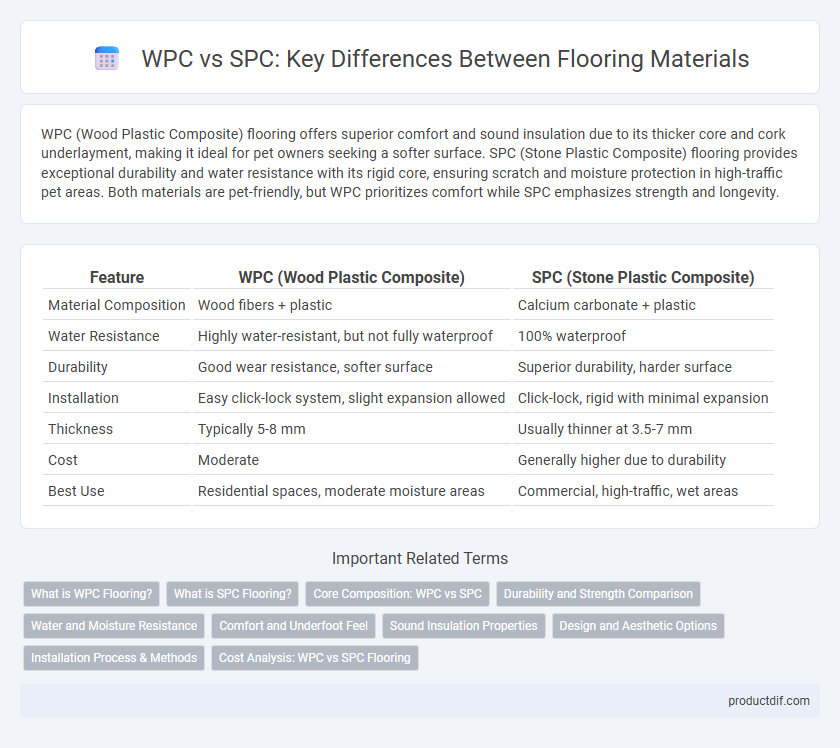WPC (Wood Plastic Composite) flooring offers superior comfort and sound insulation due to its thicker core and cork underlayment, making it ideal for pet owners seeking a softer surface. SPC (Stone Plastic Composite) flooring provides exceptional durability and water resistance with its rigid core, ensuring scratch and moisture protection in high-traffic pet areas. Both materials are pet-friendly, but WPC prioritizes comfort while SPC emphasizes strength and longevity.
Table of Comparison
| Feature | WPC (Wood Plastic Composite) | SPC (Stone Plastic Composite) |
|---|---|---|
| Material Composition | Wood fibers + plastic | Calcium carbonate + plastic |
| Water Resistance | Highly water-resistant, but not fully waterproof | 100% waterproof |
| Durability | Good wear resistance, softer surface | Superior durability, harder surface |
| Installation | Easy click-lock system, slight expansion allowed | Click-lock, rigid with minimal expansion |
| Thickness | Typically 5-8 mm | Usually thinner at 3.5-7 mm |
| Cost | Moderate | Generally higher due to durability |
| Best Use | Residential spaces, moderate moisture areas | Commercial, high-traffic, wet areas |
What is WPC Flooring?
WPC flooring, or Wood Plastic Composite flooring, is a hybrid material combining wood fibers and plastic polymers for enhanced durability and water resistance. It features a core made of compressed wood and plastic, providing a softer, more cushioned feel underfoot compared to traditional vinyl flooring. WPC flooring is ideal for areas prone to moisture, such as kitchens and basements, due to its superior waterproof properties and resistance to warping.
What is SPC Flooring?
SPC flooring, or Stone Plastic Composite flooring, is a highly durable luxury vinyl flooring option made from a blend of limestone, PVC, and stabilizers, offering superior rigidity and water resistance compared to WPC flooring. Its dense core structure provides enhanced stability, making SPC ideal for high-traffic areas and moisture-prone spaces like kitchens and bathrooms. SPC flooring features a waterproof design, scratch resistance, and easy maintenance, positioning it as a top choice for both residential and commercial applications.
Core Composition: WPC vs SPC
WPC flooring features a wood-plastic composite core composed of wood fibers and thermoplastic polymers, offering enhanced stiffness and sound absorption. SPC flooring, with its stone-plastic composite core, consists primarily of limestone and stabilizers, providing superior rigidity and moisture resistance. The core composition directly influences durability, comfort, and installation options for both WPC and SPC flooring types.
Durability and Strength Comparison
WPC (Wood Plastic Composite) flooring offers superior comfort and flexibility but is generally less dense than SPC (Stone Plastic Composite), resulting in slightly lower durability and impact resistance. SPC flooring incorporates a limestone core, making it denser and more rigid, which enhances its strength and resistance to dents, scratches, and heavy foot traffic. This makes SPC the preferred choice for high-traffic commercial spaces, while WPC suits residential areas where comfort and warmth are prioritized.
Water and Moisture Resistance
WPC (Wood Plastic Composite) and SPC (Stone Plastic Composite) flooring both offer excellent water and moisture resistance, with SPC providing superior performance due to its 100% rigid core made of limestone and stabilizers. WPC incorporates a wood-plastic composite core that offers enhanced comfort and sound absorption but is slightly less resistant to prolonged moisture exposure compared to SPC. This makes SPC flooring ideal for high-moisture areas such as bathrooms and kitchens, while WPC is suitable for residential spaces requiring moderate water resistance with a softer feel.
Comfort and Underfoot Feel
WPC (Wood Plastic Composite) flooring offers enhanced comfort and a softer underfoot feel due to its thicker, foam-based core, which provides superior sound absorption and cushioning. SPC (Stone Plastic Composite) flooring features a denser, rigid core that delivers greater durability but a harder surface, resulting in less comfort underfoot compared to WPC. Homeowners seeking a balance of resilience and comfort typically prefer WPC for areas where prolonged standing occurs.
Sound Insulation Properties
WPC (Wood Plastic Composite) flooring offers superior sound insulation due to its composite wood fibers that absorb impact noise more effectively than SPC (Stone Plastic Composite) flooring, which consists primarily of rigid stone and plastic materials. The enhanced acoustic properties of WPC reduce footstep noise and echoes in residential and commercial spaces. SPC flooring, while durable and waterproof, tends to transmit sound more directly because of its dense, rigid core composition.
Design and Aesthetic Options
WPC (Wood Plastic Composite) flooring offers a wide range of realistic wood grain textures and colors, making it ideal for achieving a natural hardwood appearance with added cushioning underfoot. SPC (Stone Plastic Composite) flooring provides enhanced design versatility with sharper patterns and a broader variety of finishes, including stone and ceramic looks, suitable for high-traffic commercial spaces. Both materials support rich visual aesthetics, but WPC excels in warmth and depth, while SPC delivers superior durability with sleek, modern designs.
Installation Process & Methods
WPC (Wood Plastic Composite) flooring features a click-lock installation system ideal for DIY projects, requiring a flat subfloor and minimal tools, while SPC (Stone Plastic Composite) flooring also uses a click-lock method but demands a more rigid subfloor due to its denser core. WPC's softer core offers better cushioning and sound absorption during installation, whereas SPC's rigid core allows it to withstand heavier traffic and support underfloor heating with ease. Both flooring types provide waterproof solutions, but SPC typically requires professional assessment to ensure proper subfloor preparation and precise installation.
Cost Analysis: WPC vs SPC Flooring
WPC flooring generally costs less upfront than SPC due to its wood-plastic composite core, offering affordability for budget-conscious projects. SPC flooring, while initially more expensive, provides superior durability and a denser limestone core, leading to longer lifespan and lower maintenance costs over time. Evaluating the total cost of ownership, SPC's resistance to dents and moisture can result in better value despite the higher initial investment.
WPC vs SPC Infographic

 productdif.com
productdif.com